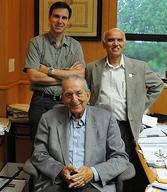 By using fumed silica impregnated with polyethlenimine, researchers at the USC Loker Hydrocarbon Research Institute aim to recycle harmful excess carbon dioxide in the atmosphere. Their new material can absorb carbon dioxide from both dry and humid air and can release it simply by heating it up. With ongoing research, the scientists hope this technology will help turn carbon dioxide into a renewable fuel source for humanity.
By using fumed silica impregnated with polyethlenimine, researchers at the USC Loker Hydrocarbon Research Institute aim to recycle harmful excess carbon dioxide in the atmosphere. Their new material can absorb carbon dioxide from both dry and humid air and can release it simply by heating it up. With ongoing research, the scientists hope this technology will help turn carbon dioxide into a renewable fuel source for humanity.One day in the future, large artificial trees made from the material could be used to lower the concentrations of the greenhouse gas in the Earth’s atmosphere. Until then, the material can be used to scrub the air inside submarines and spacecraft, as well as certain kinds of batteries and fuel cells.
The material is the latest advance in an ongoing project at the USC Loker Hydrocarbon Research Institute that aims to recycle the harmful excess of carbon dioxide in the atmosphere into a renewable fuel source for humanity – an anthropogenic (caused by human activity) chemical carbon cycle. The institute is housed at the USC Dornsife College of Letters, Arts and Sciences.
The project seeks to solve two of the world’s greatest problems at once: the increase in atmospheric greenhouse gases and the dwindling supply of fossil fuels burned to create that issue.
“Carbon dioxide is not a problem,” said George Olah, Distinguished Professor of Chemistry atUSC Dornsife. “Nature recycles it. Mankind should too.”
Olah collaborated on the project with fellow corresponding authors G. K. Surya Prakash and Alain Goeppert, as well as Miklos Czaun, Robert B. May and S. R. Narayanan. The results were published in the Journal of the American Chemical Society in November.
Olah described his work on the anthropogenic carbon cycle as the most important work of his career – eclipsing even his work on carbocations in superacids that earned him a Nobel Prize in Chemistry in 1994.
The researchers’ new material is a fumed silica (the thickening agent in milkshakes) impregnated with polyethlenimine (a polymer) – and was found to absorb carbon dioxide well from both dry and humid air. Once the carbon dioxide is captured, the material can be made to release it simply by heating it up.
Though the work is ongoing, Olah and Prakash hope to find a low-cost, low-energy method of turning the captured carbon dioxide into methanol – which can be burned as a fuel source and used as a chemical feedstock.
“It is basically assuring a long-lasting renewable source of one of the essential elements of life on Earth,” Olah said.
The research was supported by the Loker Hydrocarbon Research Institute, the U.S. Department of Energy and the department’s Advanced Research Projects Agency-Energy.
Source: University of Southern California
Image: Pamela J. Johnson
No comments:
Post a Comment